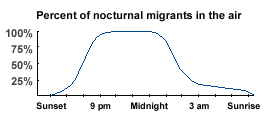 Nocturnal migrants Birds that fly by flapping their wings, such as songbirds, shorebirds, owls, herons, egrets and waterfowl, fly primarily at night. They are considered powered flyers and need a lot of energy to constantly flap their wings, so the right atmospheric conditions are important for easier flight. Atmospheric conditions Atmospheric conditions include horizontal and vertical air movements, altitudinal differences in temperature, wind strength, wind direction and humidity. Most migrants fly in an area of the atmosphere, called the boundary layer. Between sunset and dawn,the air in the boundary layer is cool and stable and many migrants take advantage of this. The cool temperature is vital to birds with sustained flapping flight because it keeps them from overheating and dehydrating.
|
Illustrations and text by LORI A. GALLO/Courier-Post
Sources: How Birds Migrate by Paul Kerlinger, Bird Migration by Chris Mead, Zoobooks
by John Bonnett Wexo, Birding by Joseph Forshaw, Steve Howell, Terence Lindsay,
Rich Stallcup
